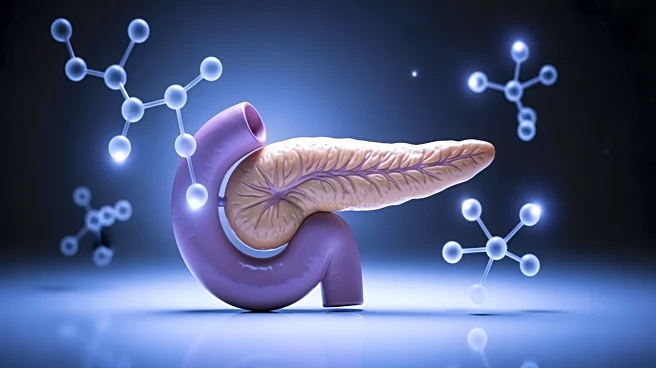What's Happening?
Recent studies presented at Neuroscience 2025 have highlighted advancements in understanding how GLP-1 receptor agonists, such as Ozempic, Wegovy, and Mounjaro, affect brain networks related to nausea,
thirst, and reward-driven behaviors. These medications, initially developed for type 2 diabetes, are now widely used for weight management due to their appetite-suppressing effects. However, they are often associated with side effects like nausea and vomiting, affecting up to 40% of users. Researchers are investigating whether these adverse effects can be separated from the drugs' weight loss benefits. A notable study found that combining low doses of tirzepatide, a dual GLP-1 and GIP receptor agonist, with oxytocin resulted in significant weight loss in obese rats without gastrointestinal side effects. This combination nearly doubled the weight loss effect compared to using either agent alone. Other studies have identified brain circuits influenced by GLP-1 drugs, including those related to reward processing and thirst suppression.
Why It's Important?
The findings from these studies are significant as they offer potential pathways to enhance the effectiveness of GLP-1 based medications while minimizing their side effects. This could lead to improved treatment options for individuals struggling with obesity and related disorders, potentially increasing adherence to these medications. The research also suggests broader applications for GLP-1 therapies beyond diabetes and obesity, such as treating binge eating and addiction disorders. Understanding the neural mechanisms involved in these processes could pave the way for developing new drugs that target specific brain regions to achieve desired outcomes without adverse effects. This could have substantial implications for public health, given the rising prevalence of obesity and related conditions in the U.S.
What's Next?
Future research will likely focus on further dissecting the neural pathways affected by GLP-1 receptor agonists to refine treatment strategies. Scientists may explore additional combinations of drugs to enhance weight loss while reducing side effects. Clinical trials in humans could be the next step to validate the findings observed in animal models. Additionally, there may be increased interest in developing GLP-1 therapies for other conditions with overlapping neural mechanisms, such as addiction and binge eating disorders. Stakeholders, including pharmaceutical companies and healthcare providers, will be closely monitoring these developments to assess their potential impact on treatment protocols and patient outcomes.
Beyond the Headlines
The exploration of GLP-1 drugs' effects on brain circuits highlights the complex interplay between medication and neural processes. This research underscores the importance of understanding the brain's role in regulating behaviors like eating and addiction, which are often influenced by reward systems. The ethical considerations of using such medications for non-diabetic purposes, particularly in the context of weight management, may also come under scrutiny. As the scientific community continues to unravel these mechanisms, there could be broader discussions about the implications of manipulating brain chemistry to alter behavior and the potential societal impacts.













